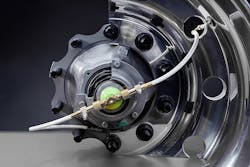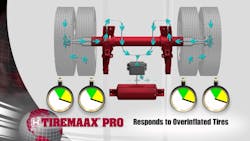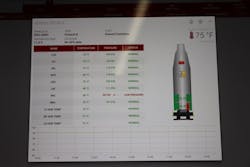Pumping up TPMS and ATIS maintenance practices
Tire issues can deflate any fleet’s day, on both the road and in the back office, with blowouts creating safety hazards on highways and scheduling issues for management, explained Collin Shaw, ZF’s North American marketing & business development leader, commercial vehicles.
He noted blowouts—and those really bad days—usually stem from underinflation. The American Trucking Associations Technology & Maintenance Council found a tire continuously underinflated by 20% cuts its life by 30%, while 40% reduces it by 50%. And even on a good day, underinflation leads to lower fuel efficiency.
The CV industry has several solutions to address underinflation and poor tire health, from the rudimentary (and questionably accurate) tire thumper to the newer high-tech, data-collecting rollover monitoring devices. In between, there are the two most common ways to solve the dilemma: tire pressure monitoring systems (TPMS) for the tractor, which passively alert drivers and management to tire health issues; and automatic tire inflation systems (ATIS), which actively regulate trailer tires’ psi to prevent under- and overinflation.
Both have their advantages individually, and even more when combined, but fleets should also be prepared to handle the maintenance workload, as well as manage the data to improve their tire programs in general.
TPMS
A TPMS solution uses sensors attached to the tire or wheel, such as directly to the valve stem or in the wheel, to determine pressure. These signal to the driver via a light on the dash when the threshold for underinflation is reached. Fleets and shops use handheld devices to program and gather sensor data, program them, and check health. Wider-ranging solutions can track several trucks at a time. The ContiConnect Yard Reader from Continental, for example, has a 65-ft. radius and sends all vehicles’ tire pressure and temperature data to a digital portal.
This can drastically slash inspection time in the yard, noted Jonathan Gravell, vice president of business development at Pressure Systems International (P.S.I.).
“I’m not going to go check 2,000 trailers, I’m going to go check the 20 that I could see are in red, and walk straight to them,” he said.
Before getting to any level of tire monitoring, each sensor does need to be set up individually.
A handheld device or laptop is required to connect to the onboard TPMS receiver.
“TPMS tools decode the sensor data such as ID, pressure, frequency, battery status, and accelerometer,” explained Bosch Product Manager Danijela Haskin. “They also activate recognized OEM and universal TPMS sensors when sensors are replaced.”
Bosch’s TPMS tools also detect if a sensor has failed, showing battery life if it is running low, Haskin added.
Boyle Transportation, named Best Fleet to Drive For by the Truckload Carriers Association, employs Bendix SmarTire TPMS. The sensors are attached to the wheel rims. Ernest Acevedo, fleet manager for Boyle’s 80 tractors and 200 trailers, explained that the fleet’s classic and “new” Freightliner Cascadia go about this a different way. The older models use a handheld device and the newer ones rely on Bendix ACom Diagnostics Software.
“The programming is pretty straightforward and intuitive,” Acevedo offered. Boyle sets its alert threshold at 15% underinflation and extensively trains drivers to understand what the alerts mean and not to ignore them.
He noted when a sensor is installed or replaced (if a battery goes bad, for instance), a technician must remove the tire to replace it.
New sensors must go through a relearning process, something more challenging during an unexpected tire changeout. If a truck suffers a blowout on the road, Acevedo reminded that emergency road service might not have the TPMS device.
Shaw recommended that fleets replace a tire’s TPMS sensor when the tire is changed to keep them on the same interval.
Away from the shop, though, obtaining the TPMS sensors proves difficult, Acevedo said. This could leave the tire without health monitoring, a loose end that might get forgotten about.
To ensure Boyle’s fleet doesn’t lose track of such repairs, their drivers log the service event on the Fleetio maintenance app.
“Once that report has been done, it automatically creates a work order and sends an email,” Acevedo said. “Essentially, we know everything that needs to be done on that vehicle as soon as it comes into the shop.”
The management platform includes a reorder button for parts and also offers transparency by providing current inventory and historical data such as how many sensors were used in the past year and how much they cost. This allows Boyle to practice just-in-time inventory management and always have enough TPMS sensors in stock, Acevedo said.
The good news for Boyle, which carries high-value assets such as military technology, pharmaceuticals, and even presidential library items, is that their drivers rarely, if ever, are waylaid by tires issue on the road. “I can’t tell you the last time we had a blowout,” Acevedo proclaimed.
Though TPMS sensors are designed to last the life of the tire, failures can still happen, Shaw said. These sensors are after all only inches from the asphalt, which is rife with debris waiting to pummel them.
“Generally, the most vulnerable ones sit outside the wheel on the actual stem,” Shaw said. “Those inside the wheel are a little bit more protected, obviously, because they’re inside the wheel.”
Alcoa recently released forged aluminum dual valve wheels so that the TPMS sensor has its own stem, while the other is left to accept air. “This really makes the inflation of the tire and the ongoing maintenance that much easier for our fleet customers,” said Lee Demis, VP of business development at Doran Manufacturing, which makes TPMS sensors.
ATIS
Boyle also employs ATIS, which are fairly simple systems that draw air from the tractor compressor and use regulators to keep tire pressure at a set level. Most fleets spec ATIS on their new trailers nowadays. Adoption of ATIS on new trailers now stands at 70%, according to Hendrickson, a provider of the technology. In 2013, the North American Council on Freight Efficiency found only 10-40% of new trailers were equipped with ATIS.
The pace has been speeding up. It took about 23 years (1992-2015) for one million Meritor Tire Inflation Systems (MTIS by P.S.I.) to be sold. MTIS also includes wheel-end heat-sensing technology. From 2015 to 2019, another 500,000 were sold, according to P.S.I.
And the accelerated pace is for good reason, as an American Trucking Associations benchmark study found top fleets double the time between tire downtime events by spec’ing ATIS.
Hendrickson’s top solution, the TIREMAAX Pro, which Boyle uses, not only ensures tires avoid underinflation, but the system also relieves air pressure to prevent overinflation and equalizes pressure among all the trailer tires for a uniform ride. This helps when traveling from cold to warm climates, as cold air is denser, and will expand when the temperature rises.
“A lot of times these tires end up overinflated, because most tire inflation systems have a one-way check valve that doesn’t allow the air to get back out,” explained Matt Wilson, general manager of Hendrickson’s control unit. “TIREMAAX Pro will automatically relieve excess pressure.”
Overinflation pulls a tire’s edge off the road and increases irregular wear. “You’re not getting the optimum contact patch that you’d like to see with the road,” Wilson noted. “The tire doesn’t scrub itself clean and once it starts, irregular wear tends to propagate and get worse very quickly.”
Recently, the company released the TIREMAAX PRO-LB, which also provides load-based pressure adjustments. The system works only on trailers with air ride suspensions, and “uses the pressure from the air spring as a pilot signal to the controller so that the controller can provide the correct pressure out to the tires,” Wilson said. Basically, the pneumatic system optimizes pressure for the current axle load. Suitable duty cycles include less-than-truckload, pickup and delivery, and bulk transport operations where the tanker runs empty 50% of the time.
To prevent irregular wear due to differing dual tires psi, Link Manufacturing offers a simple solution called the Cat’s Eye. It comprises a hose connecting the juxtaposed tires and a gauge that works to balance their psi level. If the “eye” on the gauge is centered, pressure is even. If off-center, that indicates uneven pressure.
“If you’ve got one tire that’s running 5% lower than the other, it starts to drag, so you get a lot of wear,” said Mark Molitor, Link’s senior product manager for chassis and suspensions. He explained in the case of duals with inflation levels of 95 and 100 psi, respectively, the less inflated tire would drag 13 feet per mile.
“Just connecting the duals is going to save your tires and save your fuel by making sure that you don’t have one scrubbing,” Molitor said.
The major maintenance requirement for ATIS is ensuring there are no leaks in the air system.
Wilson advised fleets routinely look out for chafed airlines and leaks, and at least once a year, check the actual output of the controller is what it is set up to be.
The system uses regulators [which] have springs and diaphragms that, over time, can drift, he said. “We’ve got special tools [for TIREMAAX PRO and PRO-LB] that allow you to connect to the controller to read the tire pressure output and also help readjust it if necessary.”
Shop air would be required to change the settings, but not to just check the output.
Gravell noted that for the Meritor ATIS, one issue is that technicians unfamiliar with the system might turn the system off the air supply to work on something and then not open it back up.
Acevedo relayed that for the TIREMAAX, the white light on the system indicates it’s in operation. And he said it’s almost always in operation, due to tire inflation or a leak in the system. Whatever the reason, Boyle wants to know why to fix the reason.
“We train our drivers to go out there and find it, and then we react off that information,” he said. “It’s almost always a nail in the tire. If it’s a huge bolt in there, you’re going to have to do something about it right away.”
Boyle also routinely checks for leaks, stemming from cut hoses or loose fittings. There are automatic leak tests out there, but Boyle technicians use the low-tech, but still effective method of a spray bottle full of soapy water. Technicians are trained to start at wheels and spin the tires and check for pinched hosing, and then work back to the axle and then to the unit itself.
“You’re not getting any more than what you would get from a driver, so we look at stuff like that,” Acevedo said. “Plus, we’re so inundated with dashboards for everything. I think we’re going to wait until the smoke clears. And then everybody starts doing what they should be doing, which is sharing that data through one system.”
Managing the data
Some fleets have begun to complement ATIS by spec’ing TPMS on trailer tires along with the tractor steer and drive positions.
“Tire inflation will put air to trailer tires while the truck’s moving, but the TPMS on the trailer will now let you know, specifically, which tire is having an issue and to what severity,” P.S.I.’s Gravell explained. If a tanker trailer has a large nail in a tire, the ATIS by itself would just keep pumping air into it, while the TPMS would identify which tire has an issue, the severity, and share that data with management.
For severe alerts, the driver might be ordered to pull over right away to prevent a blowout.
“If a tire is 5 to 10 lbs. low, but it’s not falling anymore, you may not really be all that inclined to pull the driver over,” Gravell said.
Gravell said P.S.I.’s solution reduced one regional pickup and delivery fleet’s roadside calls by 70%.
ZF’s Shaw also advocated for TPMS and ATIS working in tandem on the trailer.
“If the TPMS tells me the ATIS has been working and pumping all day, that means I have a leak, and maybe a failure coming up,” Shaw said. “It allows for a fleet to do the necessary planning; it’s always harder to plan in an emergency. Even if it’s only a couple of hours, you can call ahead to the driver and say, ‘Hey, I think you can make it 10 or 20 miles down the road.’”
Hendrickson’s WATCHMAN wheel-end solution, available this year, will have TPMS along with wheel-end temperature sensing.
“[Combining TPMS and ATIS] does bring you a little bit more clarity on exactly what’s going on with your tires, specifically when the trailer is parked,” Wilson said.
The data flows wirelessly from the hubcap via RF to a gateway module on the trailer, which then connects with the truck’s telematics. WATCHMAN will be optional for both TIREMAAX offerings.
“If you do a tire rotation or you have to change a tire, you don’t have to change the locations of your [TPMS] sensors, because they remain where that axle is,” Wilson said.
If spec’ing both systems on a trailer, the fleet needs to know the value outweighs the total cost of ownership.
ZF’s Shaw asserted the conversation has gone from advocating for TPMS in general, which “everybody really understands the value of,” to understanding the data. And the next step to improve tire health across the industry, he said, is “making sure we can then deliver that information to drivers and fleet maintenance managers, so they have transparency and information.”
And to do that, fleets should understand who gets the data and the actions to take, such as calling the trucker to warn a catastrophic tire failure is imminent.
ZF is starting to do this by linking its connected TrailerCAST solution to the OptiTire TPMS from Wabco, which ZF acquired in 2020 and now calls Commercial Vehicle Control Systems.
Shaw noted the Wabco OptiTire TPMS can provide up to a 2% fuel savings, as well as preventing ERS calls. A fleet can use Wabco Toolbox Plus to configure tires to the optimal range for best efficiency.
“You’ll see a lot of investment into just getting the information to the right people rather than just having TPMS on the truck or trailer,” he said. In January, ZF formed the Commercial Vehicle Solutions division to further this goal.
Data is also vital for Acevedo, who prides himself on his analytics knowledge. He watches the data to ensure drivers follow up when TPMS signals an underinflation issue, and those drivers are trained not to ignore these issues.
“They know that we’re watching, and we teach them how to use it, and we give them that outlet to call and get educated, if they’ve forgotten,” he said.
As for installing TPMS on trailer tires, Acevedo will wait for smart trailer technology to mature and make more economic sense for smaller fleets.
“This industry is still fighting about how that information is going to be supplied, so we haven’t gone down that road yet,” he said.
About the Author

John Hitch
Editor-in-chief, Fleet Maintenance
John Hitch is the award-winning editor-in-chief of Fleet Maintenance, where his mission is to provide maintenance leaders and technicians with the the latest information on tools, strategies, and best practices to keep their fleets' commercial vehicles moving.
He is based out of Cleveland, Ohio, and has worked in the B2B journalism space for more than a decade. Hitch was previously senior editor for FleetOwner and before that was technology editor for IndustryWeek and and managing editor of New Equipment Digest.
Hitch graduated from Kent State University and was editor of the student magazine The Burr in 2009.
The former sonar technician served honorably aboard the fast-attack submarine USS Oklahoma City (SSN-723), where he participated in counter-drug ops, an under-ice expedition, and other missions he's not allowed to talk about for several more decades.



